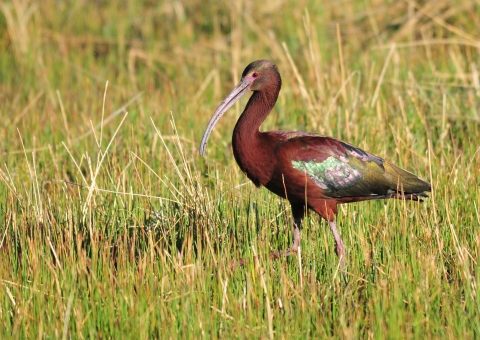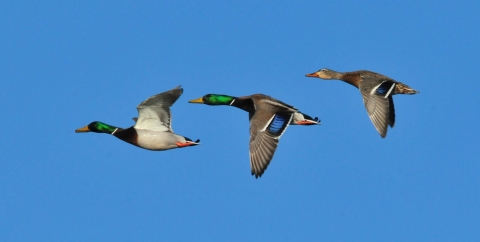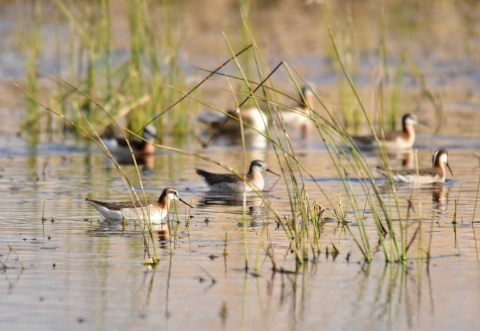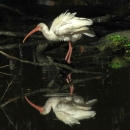Seasons of Wildlife
White-faced Ibis
The white-faced ibis is a wader that probes deep in the mud with its long bill and feeds in shallow water or on the water surface. Ibises typically feed on crayfish, frogs, fishes, insects, newts, earthworms, and crustaceans in freshwater marshes. Most white-faced ibises arrive in Montana in May; however, they typically arrive on Bowdoin National Wildlife Refuge in late April. Ibises nest in areas where water surrounds emergent vegetation, bushes, shrubs, or low trees. White-face ibis do not require colony and roosting site isolation so nesting colonies are often share with black-crowned night-herons and Franklin’s gulls. Most begin their southern movement in August, and by September they are usually gone from the State.
Mallard
Another dabbler, the mallard is one of the most familiar of ducks found throughout North America. Mallards use all wetland habitat types and depend on wetland areas and the associated upland habitats to survive. They feed on insects and larvae, aquatic invertebrates, seeds acorns, aquatic vegetation, and grain. They are well adapted to eating both natural and domestic foods such as waste grain from crop harvests. On the Black Coulee National Wildlife Refuge, mallards typically arrive the beginning of March, peak migration numbers hit in the fall, and decline as the season changes and waters begin to freeze.
Wilson’s Phalarope
Wilson’s phalaropes are small wading shorebirds that use both fresh and alkali wetlands. Commonly seen throughout the Bowdoin Wetland Management District, the phalarope feeds by swimming or “spinning” in circles. Spinning aids the bird in feeding by creating a funnel or vortex in the water that raises food to the surface.
Phalaropes arrive in the District the last week of April. Phalaropes are polyandrous, which means their sex roles are reversed. Interestingly, the females have a brighter plumage than the males, are slightly larger, she is the first to arrive on the breeding grounds, and fights with other females over males. Upon laying its eggs the female begin its southward migration, leaving incubation and all parental care to the male.
Other shorebirds that can be found in our area are avocet, black-necked stilt, willet, marbled godwit, upland sanpiper, long-billed curlew, and mountain plover.
Featured Species
Black Coulee National Wildlife Refuge offers habitat for species of the prairie pothole region. Short to mixed grass prairie dominates the uplands, while the low areas are dominated by wet meadows and wetland vegetation. Through the seasons, wildlife and plant life changes. Spring will have migration of many different bird species along with various flowering forbs. Summer will entail nesting birds both in the prairies and in the wetlands, and grasses will start to go dormant due to limited precipitation and warmer days. Grasshoppers will start to come out in late summer. By fall, migration is back on as waterfowl from all around start making their way south. Winter is by far the quietest time of year. If you are lucky you might catch a snowy owl on a fence post, or a flock of sharp-tailed grouse. The open view is available year round, but it too changes colors with the seasons.




